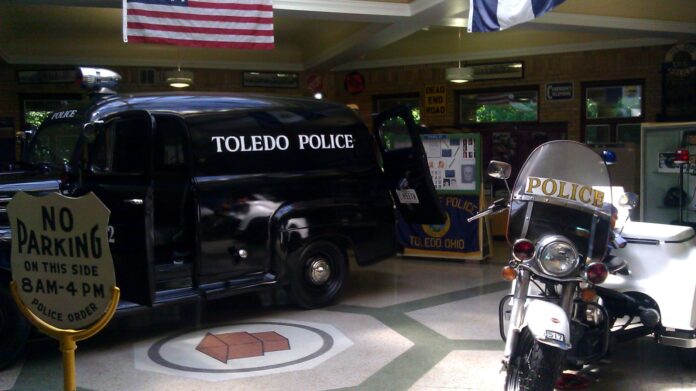
The voice of the late James “Jimmy” Ogle echoes through the Toledo Police Museum on Kenwood Boulevard. A speaker projects the former Toledo police officer’s yearly Christmas Eve broadcast, urging anyone on duty to be on the lookout for a red-suited suspect:
“Attention all cars and listeners: Be on the lookout for a short, jolly individual dressed in red and trimmed in white, who is constantly saying, ‘Ho Ho Ho,’” he would say. “Subject was last seen operating a sleigh being pulled by eight reindeer southbound from the North Pole. The subject’s method of operation is that he spreads joy and cheer everywhere. If this subject is observed, all units are advised to assist this subject as much as possible. If found, this subject will bring happiness all year long.”
Christmas Eve 2011 was his final holiday greeting to his peers.
A few feet away, Sarah McLaughlin’s “Angel” plays behind a video of late Detective Keith Dressel’s funeral from Feb. 26, 2007. A white hearse drives slowly, flanked by Toledo Police Department (TPD) squad cars. Toledoans look on from the nearby sidewalks.
On the opposite wall, a plaque hangs over a wooden mantel. On it are 30 names, all Toledo Police officers. All were killed on duty.
Ogle, Dressel and more of Toledo’s fallen heroes are immortalized inside the stone walls of the Toledo Police Museum.
Discovering history
The museum, which opened to a crowd of 300 on June 9, 2011, was designed so Toledoans could “discover the history of the Toledo Police Department” and remember those who lost their lives, according to the museum’s website.
“I’ve had many people say [opening night] was like a magical night. It was so rainy the week before we opened, we were afraid it was going to be that way when we opened,” said officer Beth Cooley. “But it wasn’t. That night was the most beautiful, perfect night. Even the mosquitoes were afraid to come out to bother us.”
Cooley, a TPD veteran since December 10, 1993, said officers never forget their start date and they never forget a fallen comrade.
Since TPD’s inception in 1867, 30 men have died while on duty.
“We promised that we will not forget,” Cooley said. “We call it our ‘solemn obligation’ to never let time diminish the sacrifices they have made. That’s the part closest to my heart.”
Remembering those who died too soon, the museum houses kiosks for visitors to read about the fallen officers and the circumstances surrounding their deaths.
“We have a kiosk that tells their stories,” Cooley said. “We have all of their names and their end-of-watch dates.”
For anyone wanting to explore the history of the Toledo Police Department, the museum has a variety of artifacts that showcase the evolution of TPD.
“It’s the history that has been lying around and not told. We have so many things to discover and we’ve only scratched the surface,” she said. “I have always said right now we are glossy front, and the real research and learning comes now.”
Inside, visitors can find everything from a vintage police radio and bulletproof vests to an old jail cell and a 1948 Toledo Police wagon.
Admission to the museum, 2201 Kenwood Blvd., is free.
Resurrection
Cooley manages all business operations and the 40 volunteers who work during its hours of operation. The museum is open Thursday through Saturday, 10 a.m. to 4 p.m.
In May 2010, then Police Chief Mike Navarre put Cooley in charge of resurrecting the museum, which originally stood at 525 N. Erie St. from 1985 to 1994, she said. After years of storing artifacts, Cooley and the Toledo Police Retirees Association put the wheels into motion and opened the museum eight months later.
“It was a perfect storm in a sense. The mayor helped us with the building, which had been vacant at the time,” Cooley said. “It was next to a police substation so it was kind of the obvious choice. It just looked like a museum waiting to be a museum.”
Close to home
On Sept. 18, 1970, TPD Officer William Miscannon was gunned down inside his patrol car during a race riot sparked by the Black Panthers. He was just 33 years old.
His daughter, Diane Miscannon, was only 10 at the time.
After growing close to Detective Dressel’s parents, Larraine and Mike, Diane was not only inspired to help with the annual Dressel Ride, she was also inspired to commemorate the life of her father.
Starting the second year of the Dressel Ride, Detective Bonnie Weis surprised Diane by having all proceeds from the event go to the Officer William Miscannon Scholarship Fund at Owens Community College.
“I started bawling like a baby when they told me,” she said.
After reading about the museum needing volunteers, Diane jumped at the chance to devote her time to TPD history. Though, she was completely unaware of how fate would play out.
“I did it to be closer to my father, but I didn’t even think about it right away that the day I started at the museum was Feb. 21, 2011, the anniversary of Keith’s death,” she said.
99 to go
Cooley said the museum must sustain itself so future generations can experience the city’s rich history.
“We want to be here in 100 years,” she said. “We don’t just want to be here for five years and leave, so it’s important to come up with a feasible plan to sustain ourselves.”
Cooley keeps fighting for the history of the Toledo Police Department.
“We have had an amazing history with some cool stuff that no one’s ever known because they’ve just been tucked away,” she said. “Now we have the opportunity to see how our city has grown through eyes of the police department. When you look back and see history through eyes of police, it helps people understand why we do what we do. Without that, we’re a little less rich.”






















